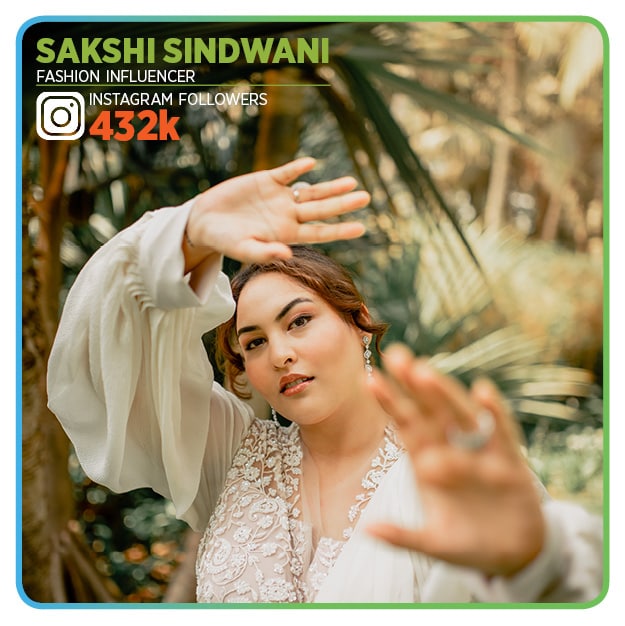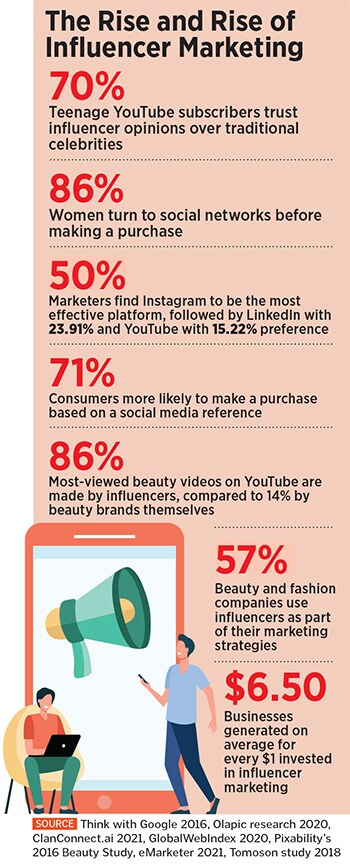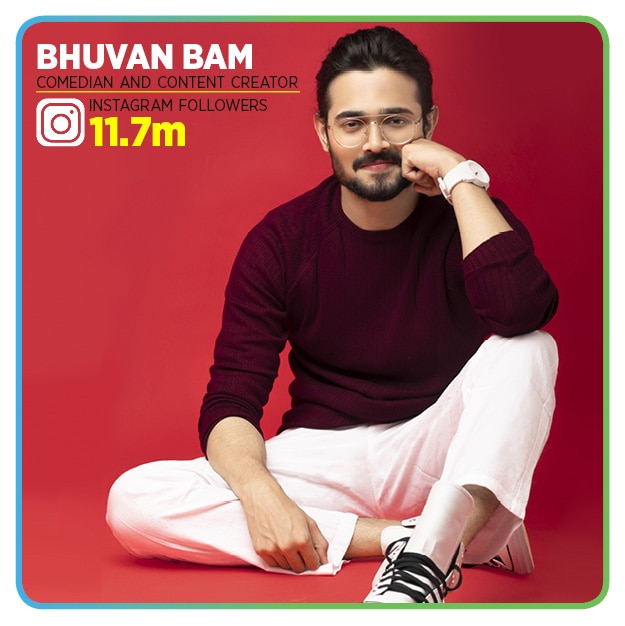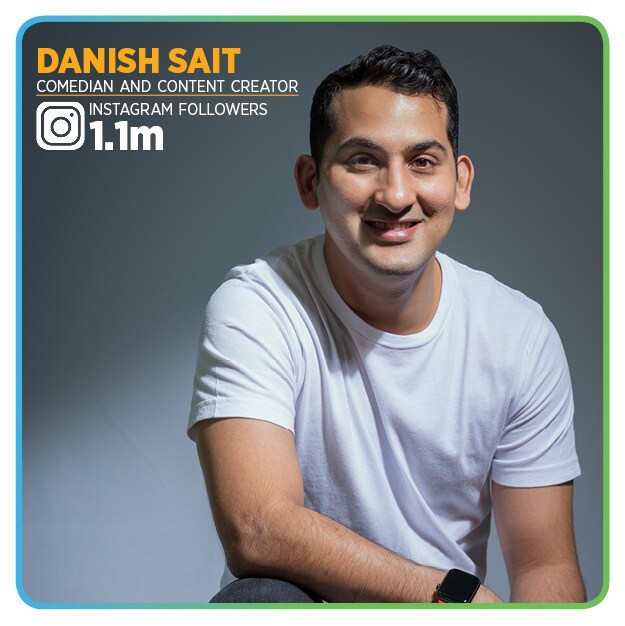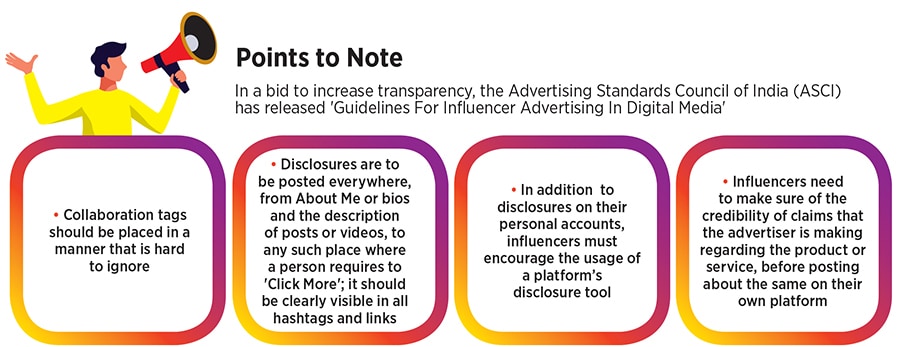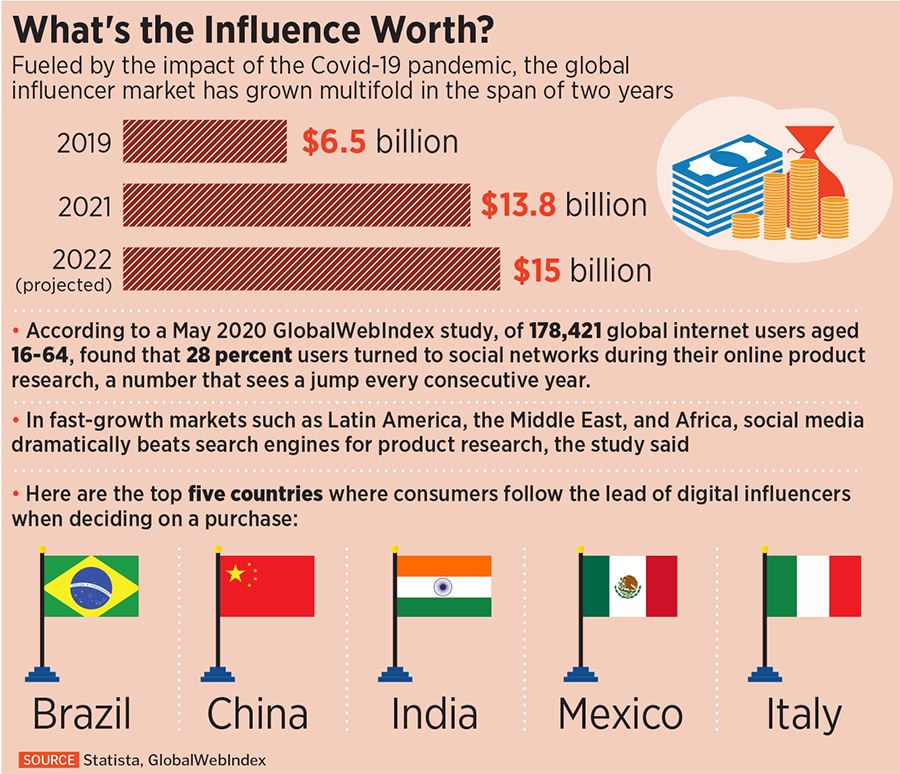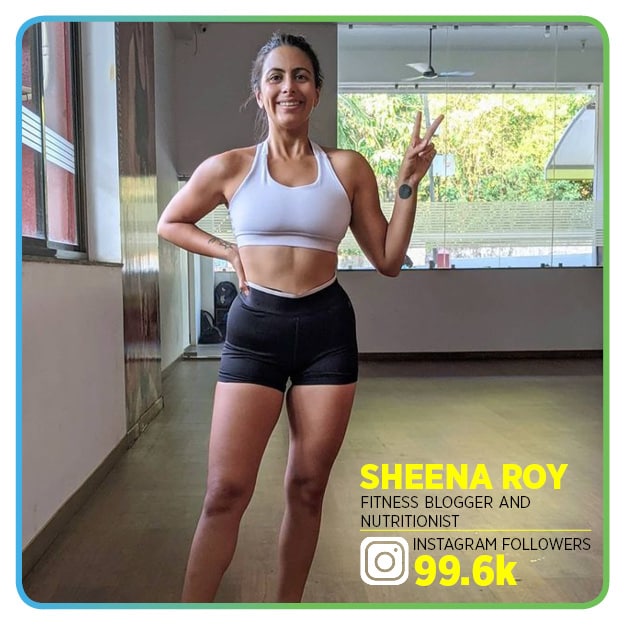“People don’t follow me for the brands I promote, so whenever I collaborate, the aim is to always be as authentic as possible without letting the brand overshadow my story," says content creator Vishnu Kaushal, who shot to fame for creating short, snappy, relatable comic videos based on everyday people, situations and incidents. Brand promotions, therefore, also have a similar focus and tone. “I’ve always communicated with the brands I work with that I"ll make use of the product my way. My priority is making content enjoyable for my audience and not being an online salesman for brands," says 24-year-old Kaushal, who has over 500,000 followers on Instagram.
For this, an influencer often makes dedicated investments of time and effort at every stage of content production for a brand collaboration.
![]()
“I am a body advocate, and a lot of brands that approach me have such questionablestances on beauty or fitness," says Sakshi Sindwani, a fashion and fitness influencer. “I make it a point to only endorse brands that are open to have a dialogue and not hand down a script." The 25-year-old gives an example of a collaboration with [sports nutrition brand] Myprotein, where she built a story combining fitness and body positivity. “The campaign did super well for the brand and the response I got from my audience was phenomenal too. It was a win-win for both of us," Sindwani explains.
This is unlike endorsements by high-profile celebrities, who are often not as involved in content production process as influencers.
The evolution story
Eight years ago, when Savi Munjal and Vidit Taneja started their travel blog, Bruised Passports, influencer marketing was almost non-existent. "Over the years, we have seen brands become a lot more conscious about the kind of work it takes to produce good content, [and build] an engaged community," says Taneja.
![]()
The influencer marketing business was worth $9.7 billion in 2020 and is expected to grow to $15 billion by 2022, estimates influencer marketing agency Mediakix, with half the brand marketer community saying it spends more than 20 percent of their budget on influencer content.
“While there has been a jump in digital ads, it is a natural reaction to skip or scroll past an ad—meaning that co-creating smart integrated content with influencers who have content that people want to watch—is so important," says Julie Kriegshaber, COO, Chtrbox, an influencer marketing company.
A number of non-legacy D2C brands, such as personal care companies like Plum, Mamaearth and mCaffeine, have built an ‘influencer-first’ marketing strategy through active online communities. Legacy brands are also following suit in a bid to stay relevant, with sectors like banking, finance and insurance also jumping on the bandwagon.
Homegrown consumer electronics upstart boAt is one such brand that has worked with influencers for over four years now. “Influencers have been a core asset to boAt"s journey," claims a boAt spokesperson. The brand currently works with about 100 micro influencers on a regular basis, apart from bringing in multiple celebrity endorsers on board, including cricketers Shreyas Iyer and KL Rahul, singer Neha Kakkar, actor-singer Diljit Dosanj and actor Kiara Advani.
![]()
The strategy of having a healthy mix of celebrity brand ambassadors and influencers has worked for boAt. "When we want to do something for the masses we go to our brand ambassadors and when it is something niche, we reach out to the micro influencers," the spokesperson says, adding that micro influencers have helped the company reach entire new markets.
A legacy luxury goods brand like Moà«t Hennessy has seen marketing trends evolve dramatically, especially during the pandemic. "The digital space is no longer a blur but another world in itself, which has also made marketers rethink strategies from what these were last March," says Sophia Sinha, marketing head, Moà«t Hennessy India. “Because the digital space is so fickle in its memory and changes happen so fast, getting the right kind of “influencer" to talk to your consumer becomes necessary."
The increasing level of awareness among consumers is also adding to the shift of branding strategies in favour of influencers. In the last two-three years, brands are also making an effort to understand content creators, which has in turn led to influencer marketing becoming more nuanced.
Munjal says that when celebrities advertise products, viewers often know that the minute the actor walks out of the set, they might not really use the product they are advertising. With influencers who share a major chunk of their personal lives with followers, the equation is different, she explains. “For instance, I cannot advocate a phone today and then not use it, because my readers know what we are using in our stories. Sometimes when we meet them somewhere, they know we"re carrying."
Trust is key
![]()
Influencers, particularly established content creators, trust the product they are advertising, which is key for all collaborations. “I only advertise brands I have personally used or I know have credibility," says Bhuvan Bam, who rose to fame through YouTube videos. Having collaborated with more than 34 brands till date, he is one of the most sought-after influencers for promotions today. He tells Forbes India that over the years, his followers have shown constant interest in the products he promotes and also constantly give him feedback. “I take all that into account. Having a trustworthy relationship with the audience will always be my priority," he says. Bam’s approach of deciding on the brand to promote is how credible the brand is and whether it is pocket friendly for his audience.
Multi-hyphenate comedian Danish Sait has worked with over 40 brands, from regional brands like Empire restaurant in Bengaluru to food tech platform Swiggy. According to Sait, "Creators like us have a different kind of connect with our audience, as opposed to what a brand would have. I think I am not an influencer, instead I am an able carrier."
![]()
He believes the minute you have followers, brands reach out to you. “They don"t come to us for creativity, creativity is by chance. Honestly, if brands and agencies had it their way, there would be rubbish ads running on every content creator’s profile," he says. “Now brands approach us, asking us to do what we do best. I enjoy working with brands that let you do what you do well."
Bam says that brands and unverified products offering handsome money for promotions are a common occurrence, "A number of brands have approached us through unverified sources, but we have never entertained them," he says.
Demand for digital dialogue
According to Dentsu’s Digital Report 2021, the advertising budget for digital media has increased from 20 percent in 2019 to 28 percent in 2020, while the market size has increased from 136.83 billion to 157.82 billion. It is expected to reach 34 percent by the end of 2022.
Marketing through influencers also offers fresh perspectives to the brand, as content creators are the ones deciding on how promotions will be done. “We have gotten so much insight from influencers, they would come up with such unique ways of talking about our products that we would not have thought of otherwise," says Siddarth Menon, CMO, yogurt maker Epigamia. “They are also a great source of first-hand audience insights, since most of them connect to their followers on a regular basis." According to him, the focus of influencer collaboration is the reach they bring to the table. “Numbers do not directly indicate the impact of influencer marketing, but we know it is the long term consumer perception through these influencers that matters," Menon adds.
Today, Indian audiences are watching more online videos than ever before. Studies by Nielsen show that home-bound consumers have led to a 60 percent increase in the amount of video content watched globally. The number of live video sessions conducted on social media platforms by content creators also hiked in 2020. As per Facebook US, in the first months of the pandemic alone, the number of users watching live video increased by 50 percent and the platform launched additional features to support video creators.
Studies have shown that a significant part of digital marketing is influencer marketing now. Owing to reduced investment and massive returns. As per an April survey by ClanConnect.ai, an AI-driven influencer marketing platform, 78 percent marketing leaders took to influencer marketing in 2020, with about 13 percent of them engaging in influencer activity for the first time last year. In a similar vein, according to eMarketer, 84 percent of marketers had contemplated launching at least one campaign featuring an influencer. From a consumer standpoint, a significant 71 percent of consumers had reported to have made purchases derived from a social media recommendation.
Choosing the right fit
Deciding on the right match for promotions is not only critical for the influencers, but also the brands as well. If a brand picks an influencer that the target audience cannot relate to, the efforts are in vain.
For instance, Brillare India, a personal care brand, tries to look at influencers whose aesthetic match that of the brand. "We look at engagement ratio for the last 10-15 campaigns that they have done. Often we see shocking results wherein the influencer might be huge in terms of followers, but the engagement is very less," says Patel.
Secondly, they also try to look for influencers who have a mature follower base, engaging with relevant questions. Some of the tools that Brillare uses to narrow down influencers include HypeAuditor, SocialAuditor and Snapppt. "The trend of having a single brand ambassador is not going to work anymore," he says. Within the skincare space, apart from dermatologists and the salon industry, influencer recommendations are likely to have equal weight in consumer decisions, claims Patel.
Influencer marketing works more directly with the consumer, says Shaan Shah, CEO, Freakins, a D2C fashion brand. “We use it to create more credibility and brand building by involving influencers with deeper connections rather than just associating for a post," he says, adding that the brand has witnessed an increase in website visits after influencer collaborations. "We"ve seen a 35 percent increase in the time spent on our website once we started influencer marketing." Says Shah. “Relatable content creation is the next big thing and brands will have to find a way to sneak in the relatability aspect."
New guidelines
![]()
The influencer marketing concept is still very new for India in Shivesh Bhatia"s opinion. The 25-year-old started his journey on Instagram while he was still in high school, thinking that it was only an editing platform. Back then, he had no idea being an influncer would become his full-time profession.
This form of marketing is very new for a lot of brands, which is why every brand has a different idea of whether or not to declare it as a "paid partnership" or an "advertisement". "It is important for creators to look at themselves as brands and have policies, and not just pushed around by what the brand might believe in," he say.
Bhatia has a hashtag called #BWSPartner, which he uses to highlight sponsored content. "A lot of brands even now are against adding the "paid partnership" tag," says Bhatia, adding that he no longer entertains barter deals as he has salaries to pay.
![]()
The Advertising Standards Council of India (ASCI) has recently come up with a set of guidelines for influencer advertising on digital media. [see box]. According to the press release, keeping in mind the growing consumption of digital advertising, the disclosure guidelines for influencers were the need of the hour.
"With the new ASCI guidelines, it gives more credibility to the industry where I think eventually we will see even more brands try it out," says Kriegshaber of Chtrbox.
Partnerships and platforms
As per industry experts, influencers charge Rs 25,000 to Rs 3 lakh per post based on the platform and the kind of campaign that is being looked at. "Brands now tend to have a fixed line item budgeted for influencer marketing from the overall marketing budget – it’s no longer an experiment. We see everywhere from 10- 50 percent of overall digital marketing budgets allocated to influencer marketing from the brands we work with," says Kriegshaber.
![]()
Most influencers are split into micro, macro and mega or celebrity influencers. According to the April 2021 ClanConnect.ai study, Instagram is the most effective platform for influencer campaigns by 50 percent of marketers, while LinkedIn took second preference by 23.91 percent and YouTube by 15.22 percent.
"Traditionally Instagram, YouTube, Twitter and occasionally LinkedIn have been what brands prefer for influencer marketing as tried and tested solutions. We’ve also seen the rise of new platforms like Dailyhunt’s Josh, Sharechat’s Moj which cater really well to regional audiences," Kriegshaber adds. According to her, Instagram is the most popular amongst budding influencers because it has a variety of different formats—short and long videos, posts and stories. Engagement has increased drastically on Instagram and dropped with Gen X and Z on Facebook.
The Way forward
Given the number of influencers today and the rate at which the market is growing, has this form of marketing hit saturation already?
"I worry about this often, especially as I grow into the mid-30s and social media is saturated with a much younger age group," says Sheena Roy, fitness influencer and nutritionist. As a way to keep her content relevant, she explains that she pays close attention to direct messages and questions she gets asked often. “I build my content around what people want to know and what helps them best."
![]()
Roy started her Instagram account as a way to document her fitness journey, not as an attempt to become an influencer. Even now, she prefers to use the platform to post content that makes nutrition easier for the average person and as a marketing tool to get clients.
Roy believes that even though being an influencer is a full-time career now, not many people entering the industry understand the responsibility of being an influencer or the responsibility that brands have towards them. “This usually ends up with influencers being undervalued and then in return marketing unethical brands just to make ends meet," she says.
"We will see influencers coming to all formats of traditional media across TVCs, OOH and product websites," says Kriegshaber of Chtrbox. “We see huge potential in regional growth and the rise of platforms catering to them." Overall, experts are bullish on the industry and given trends in other markets, it will continue to see a year-on-year growth of 20-30 percent in the near future.

 Influencers Savi Munjal, Komal Pandey, Sakshi Sindhwani and Sheena Roy
Influencers Savi Munjal, Komal Pandey, Sakshi Sindhwani and Sheena Roy 
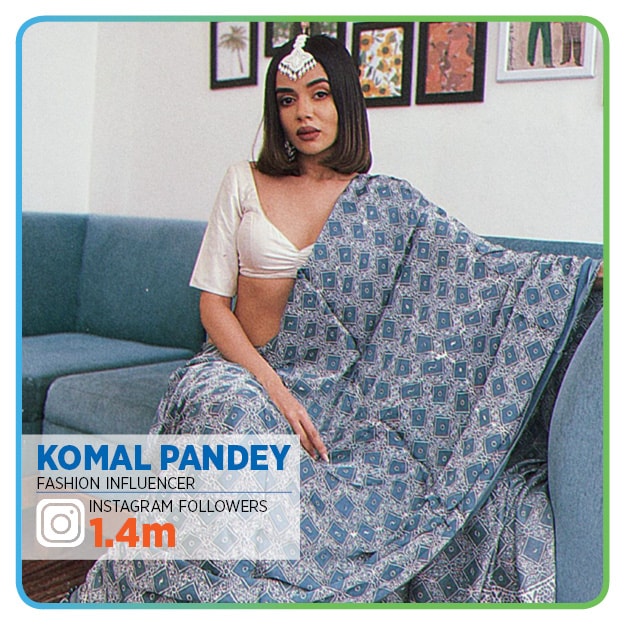 Komal Pandey, a 27-year-old
Komal Pandey, a 27-year-old 